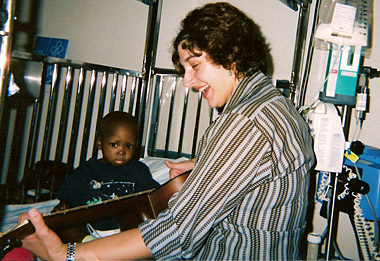Hurricane Shudders

Suzanne St. Amand performs her music therapy duties at Children's Hospital in New Orleans.

St. Amand sings lead vocals for a band in a Boston nightclub before moving to New Orleans.
Suzanne St. Amand was worried all along. She was a transplant to New Orleans, not a jaded native, and the news of the hurricane that had just passed through Florida and was recharging in the Gulf of Mexico made her uneasy. Before long, though, she wasn't the only one. By the morning of Sunday, August 28, Hurricane Katrina was rolling toward the Gulf Coast region as a Category 5 storm with winds of up to 175 mph. A Category 5 is the most ferocious storm there is, but St. Amand, a 2003 Berklee graduate and a music therapist at Children's Hospital, went to work. On any other day, she might be helping a brain tumor patient with slurred speech practice enunciation with a microphone or a stroke victim recover fine motor skills on a keyboard. But she had volunteered to help out under Code Grey, the hospital's protocol system for weather emergencies, and her job was to help care for the children of the staff working at the hospital. The first day, Sunday, wasn't so bad.
"We checked the kids in, we watched movies," St. Amand says. "No problem. It was, like, ‘We're camping. We're camping in the hospital. This is so cool.'"
St. Amand, her three coworkers, and their charges—there were 16 kids altogether, ages 1 to 16—evacuated to the third floor of the hospital as a precaution against flooding. Two patient rooms had been cleared out to act as activity rooms and sleeping quarters. When Katrina hit officially on Monday morning as a slightly downgraded but still very dangerous Category 4 storm, St. Amand and her companions were too preoccupied with the children to catch the weather reports on the television downstairs. They monitored the hurricane the old-fashioned way: they looked out the window.
"There was this big tree in the courtyard outside," St. Amand says. "We sort of gauged where the storm was by watching it be torn apart in the rain. It was the only view we had."
The winds came and went Monday with the hospital faring much better than the trees outside. St. Amand remembers her relief, though it didn't last. On Tuesday morning, she found out that the system of levees that kept the mostly below-sea-level city dry had been breached. The real catastrophe was just beginning. On that day alone, the hospital lost electricity, flushing toilets, and potable drinking water. People without connections to hospital employees or patients began showing up. Some needed shelter; others wanted drugs. Administrators warned staff members that looting was a very real possibility when the sun went down, which is why nurses armed themselves for their trips to the hospital pharmacy. Meanwhile, St. Amand was supposed to be entertaining.
"The entire time you're trying to be strong because you have 16 kids relying on you," she says. "You can't show that you're scared. You have to have fun.…So we were singing Nelly songs and Kelly Clarkson, and I was playing the guitar. We had talent shows. But I was also completely freaking out."
On Wednesday morning, reports trickled in suggesting that the soonest rescuers would arrive would be Friday. Family members of some patients had already evacuated under the assumption that their loved ones would be taken care of at the hospital, but now some staff members were talking about abandoning their posts. St. Amand was prepared to sit tight. But when supervisors began permitting interns to leave—they were unpaid, so they weren't officially required to stay—they asked St. Amand to escort the music therapy intern because they didn't want a woman to travel alone. The two were snuck out a back ambulance bay, put into a Nissan Sentra, and had to somehow get to a safe rendezvous point in Memphis. There, St. Amand would meet up with her fiancé, who had hurriedly evacuated days earlier with nothing more than some clothes, some cold drinks, and St. Amand's wedding dress. He would be driving down from his parents' house in Wisconsin. His bride-to-be and her companion had a messier ride ahead of them.
"We had to drive around power lines and these giant trees in the road," St. Amand says. "When we got to the intersection of Jefferson Highway and Causeway Boulevard…there was a crowd of probably 200 people that we had to drive through. They all wanted rides. They were knocking on the windows, jumping in the way of the car….There were helicopters all around, they were setting up a triage center at I-10. It really felt like a war zone."
The highway, thankfully, was empty, but it wasn't until they reached Mississippi that they finally found a gas station with an operational phone. St. Amand called her fiancé, who had last spoken with her seven hours earlier and had no idea how she was faring. The two were at last reunited in Memphis. Since then, St. Amand has spent time between Wisconsin, her parents' home in New Hampshire, and friends in the Boston area, where she recently guest lectured in music therapy classes at Berklee. She's still planning on returning to New Orleans. There's no job waiting for her, but the apartment is habitable. She'll live off unemployment for a while and volunteer where she can—there will be no shortage of demand for therapists. And there will also be a wedding, though not quite the one she had planned.
"The ceremony is being postponed a bit, and now it's in New Hampshire," St. Amand says. "It's not the hippie lovefest in New Orleans it was supposed to be, but it's still happening, and it's still very, very happy."
